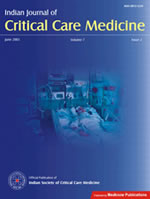
|
Indian Journal of Critical Care Medicine
Medknow Publications on behalf of the Indian Society of Critical Care Medicine
ISSN: 0972-5229
EISSN: 0972-5229
Vol. 9, No. 4, 2005, pp. 211-216
|
 Bioline Code: cm05033
Bioline Code: cm05033
Full paper language: English
Document type: Research Article
Document available free of charge
|
|
|
Indian Journal of Critical Care Medicine, Vol. 9, No. 4, 2005, pp. 211-216
| en |
Incidence, clinical outcome, and risk stratification of ventilator-associated pneumonia-a prospective cohort study
Rakshit Panwar, Nagar VidyaS, Deshpande AlakaK
Abstract
Context and Aim: Ventilator-associated pneumonia (VAP) remains to be the commonest cause of hospital morbidity and mortality in spite of advances in diagnostic techniques and management. This project aims to study the various risk factors and the common microbial flora associated with VAP. It also evaluates the use of APACHEIII scores for prognostication.
Study Design: A prospective cohort study was conducted over 1 year in medical critical care unit (CCU) of a tertiary-care teaching hospital.
Methods and Material: VAP was diagnosed using the clinical pulmonary infection score (CPIS) of more than 6. The study cohort comprised 51 patients. All CCU patients requiring mechanical ventilation for more than 48 h formed the study group.
Statistical Analysis Used: Univariate analysis, χ2-test, and paired "t-test."
Results: Twenty-four out of fifty-one cases developed VAP. These cases had an average APACHEIII score of more than 55 on admission to critical care unit (CCU). They needed prolonged mechanical ventilation and had lower PaO2/FiO2 ratio as compared with the remaining patients who did not develop VAP. Pseudomonas aeroginosa was the commonest and most lethal organism. The mortality in the VAP group was 37% and correlated very well with higher APACHEIII scores on admission.
Conclusions: Longer duration of mechanical ventilation and the need of reintubation are associated with proportionate rise in the incidence of VAP. Deteriorating PaO2/FiO2 ratio correlated well with the onset of VAP. Higher APACHEIII scores on admission stratify the mortality risk.
Keywords
APACHE III (Acute Physiology, Age and Chronic Health Evaluation) Scores, Comorbid illnesses, Mechanical ventilation, Mortality, Nonsurvivors, PaO2/FiO2 ratio, Ventilator-associated pneumonia
|
| |
© Copyright 2005 Indian Journal of Critical Care Medicine.
Alternative site location: http://www.ijccm.org/
|
|
